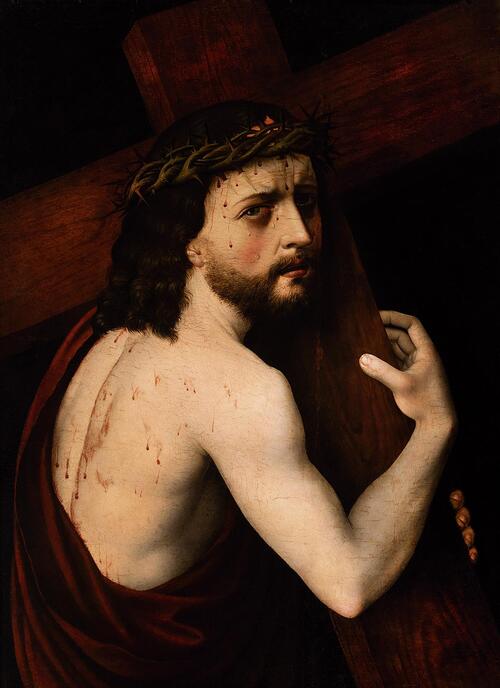Christ carrying the cross, symbol of redemption in the late Renaissance
Next October 20, Setdart will present 170 pieces at the Alta Época auction where exceptional works such as this work from the Spanish Renaissance from the Milá Collection in Barcelona stand out.
We are facing a Christ serene, who enters into a silent dialogue with the viewer. His features do not show physical pain, which is reflected in the drops of blood that fall from his head and run down his naked back. The hard work of glazing produces a realistic feel to the point that gliding tears and drops of blood appear to bulge . The thorns of the crown are inserted into the flesh of Jesus, piercing it so aggressively that when they sink, they mark the relief under the skin and even tear it, as is the case with the eyebrow. The precision with which he has executed many details gives it a high degree of realism, as in the case of the hair painted almost individually or in the grain of the wood.The cross, of which we only see part of the two logs , is presented with almost architectural resounding and thus make explicit the symbolic heaviness of the load.
The message of this passage is the very acceptance of the Passion. The suffering of Christ has an end and with full consciousness embraces the pain materialized on the cross.
The painting in question reminds us of the models of the great Leordanesque followers located in the cities of northern Italy. . Opting for a contrasting palette between the dark backgrounds and the blurred contours of the figure, while in the flesh tones and drapes (in the red tunic that wraps the torso) she uses bright colors and extracts beautiful velvety qualities. We are before a painting fully inscribed in the late Renaissance.
The iconography of Christ carrying the heavy cross on his ascent to Mount Calvary had a development of its own throughout the history of art. , the result of his adaptation to the expressive peculiarities or to the communicative habits of the plastic arts in each era. Already in early Christian art the theme was represented to allude to the symbolic role of the cross as an instrument of redemption and achievement of eternal life.
An important A turning point in the representative habits of this episode of the Passion took place during the Late Renaissance and the Baroque , both in northern Italy and in Spanish art. The Via Dolorosa and the anecdotal description of the vicissitudes that Jesus encounters during his ascent disappear to focus on the suffering and redeeming countenance, on the bust covered with a red tunic and the injured arms holding the cross. Let us remember that the representation of a whole retinue of onlookers, scoffers and friends had been common: the most frequent episodes were that of Simon the Cyrene helping him carry the cross or Veronica offering him a cloth to wipe the sweat and blood from his face.
Starting in the middle of the 16th century, in northern Italy, this other model emerged: the embodiment of a moment of great dramatic intensity of Christ in the Via Crucis, but from which all anecdotes are removed. Painters who will help define the plastic variations of this model will be Sebastiano del Piombo, Correggio or Tiziano (in the Italian case) and Luis de Morales or el Greco (in Spain).
In these works the devotional and allegorical character is intensified. In the painting that Setdart is putting out to tender these days, “Christ Carrying the Cross” (ca.1550, from the Northern Italian school, from the Milá Collection in Barcelona), the approach to the figure at the bust level gives the canvas a singular tactile character . On the other hand, Jesus does not avoid our gaze. On the contrary, his penetrating gaze seems to want to involve us in his decision to assume






